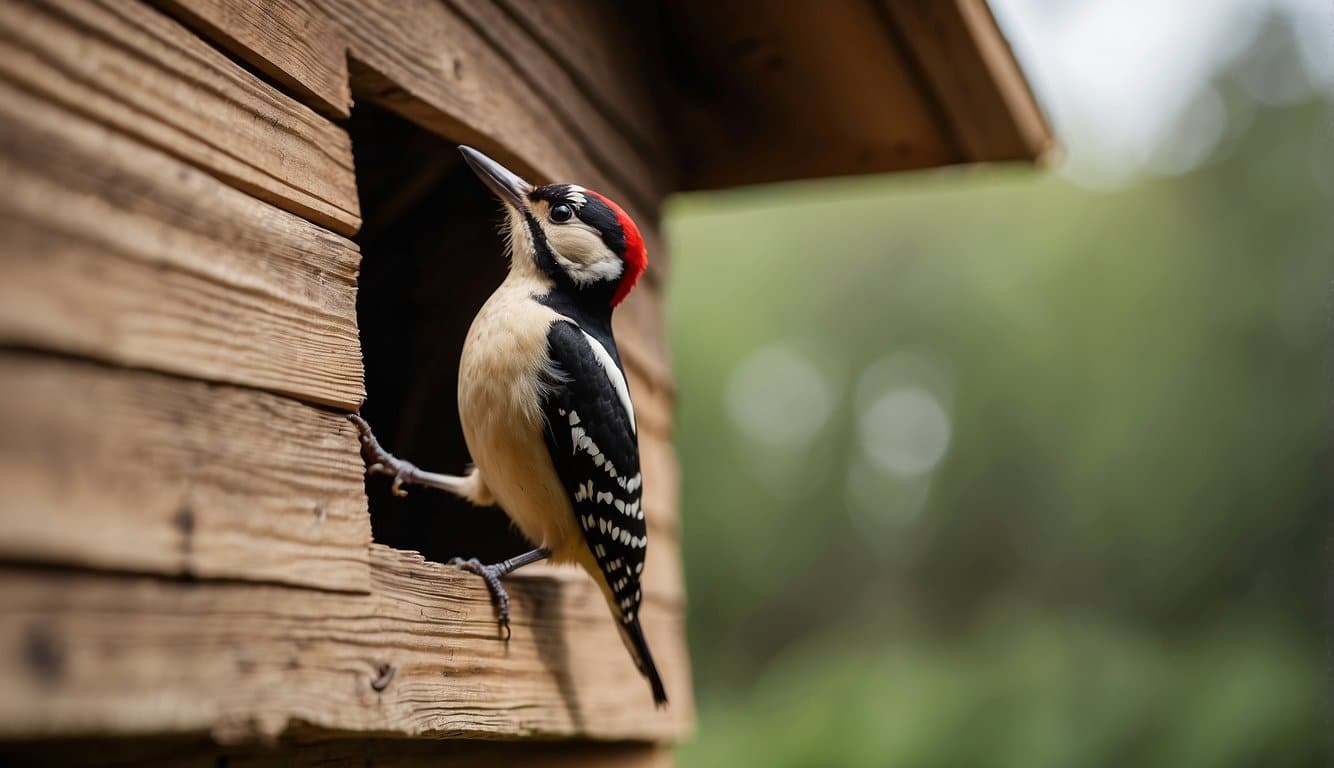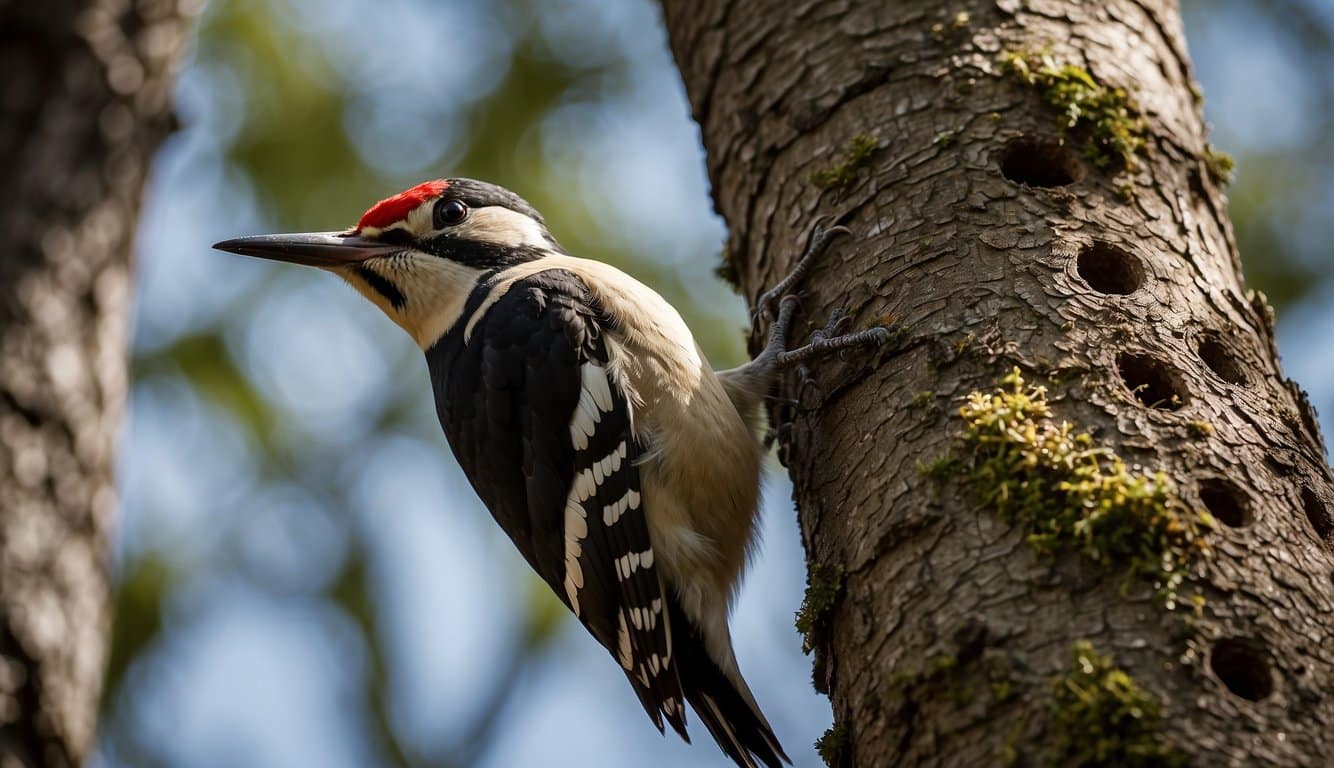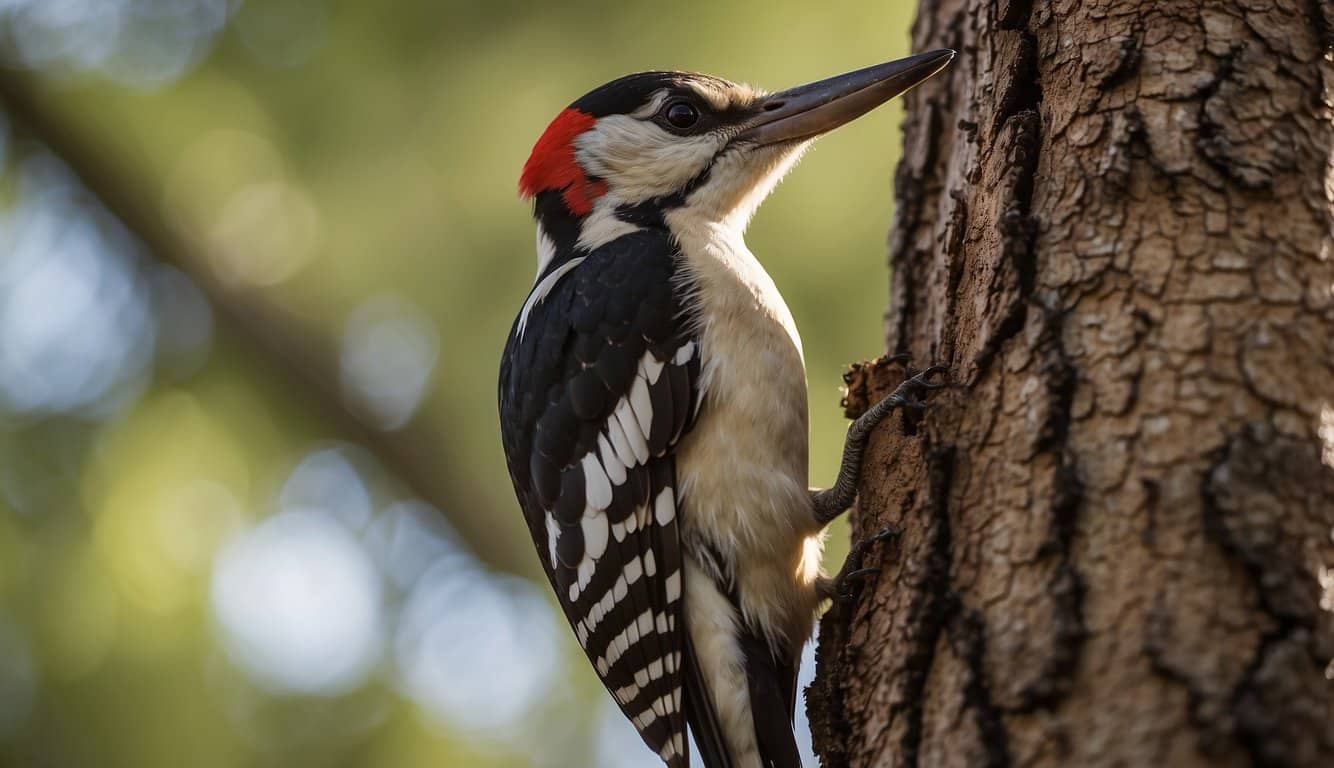Getting Rid of Woodpeckers: Step By Step
Step 1: Identify the Reason for Woodpecker Activity
- Question: Have you determined why woodpeckers are attracted to your property?
- Yes: Proceed based on the specific attraction (insects, food sources, nesting sites).
- No: Assess for signs of insect infestations in wood, availability of bird feeders, or suitable drumming surfaces.
Step 2: Remove Food Sources
- Action: Eliminate the woodpeckers’ food supply to discourage their presence.
- Pest Control: Treat wood surfaces to kill insects such as beetles and termites, which may attract woodpeckers.
- Bird Feeders: Modify or remove bird feeders if they are attracting woodpeckers.
Step 3: Block Problem Areas
- Action: Use physical barriers to prevent woodpeckers from damaging property.
- Materials: Cover affected areas with netting placed several inches from the surface to prevent woodpeckers from reaching it.
- Other Barriers: Install metal or durable plastic sheeting over damaged wood areas.
Step 4: Scare Tactics
- Action: Use visual and auditory deterrents to scare away woodpeckers.
- Visual Deterrents: Hang reflective tape, mirrors, or old CDs near problem areas to create unsettling movement and reflections.
- Auditory Deterrents: Use noise-making devices that startle the birds without causing them harm.
Step 5: Provide Alternative Pecking Targets
- Action: Offer an alternative location for the woodpeckers.
- Install a Woodpecker Box: Provide a nesting box specifically designed for woodpeckers if their presence is due to looking for nesting sites.
- Dead Trees: Leave a dead tree on your property, if practical, to attract woodpeckers away from your home.
Step 6: Apply Repellents
- Question: Do you want to use chemical repellents?
- Yes: Apply non-toxic tactile repellents on wood surfaces to discourage woodpeckers without harming them.
- No: Continue using non-chemical methods.
Step 7: Seek Legal and Ethical Guidance
- Action: Check local wildlife protection laws.
- Important: Woodpeckers are protected under the Migratory Bird Treaty Act in the U.S., making it illegal to harm them or disturb their nests without a permit.
Step 8: Professional Help
- Question: Are the DIY methods ineffective?
- Yes: Consider consulting with a wildlife control professional.
- Note: Ensure they use humane and legal methods in accordance with wildlife protection laws.
- No: Continue monitoring and adjusting the deterrent methods as necessary.
- Yes: Consider consulting with a wildlife control professional.
Step 9: Regular Maintenance
- Routine Actions:
- Inspect Property: Regularly check your property for new damage or signs of woodpecker activity.
- Update Deterrents: Refresh or change the placement of deterrents to maintain their effectiveness.
Identifying Woodpecker Damage
Hey, nature detective! Your first clue in solving the mystery of the feathered culprits? Woodpecker damage. Let’s zero in on what to look for:
- Circular Holes: They’re like woodpecker calling cards. Neatly drilled rows of small holes, seeking insects or creating nests.
- Tree Damage: Usually, it’s the dead limbs they peck, but if they’re hitting living parts, it’s urgent to intervene.
- Noise: That rhythmic drumming isn’t a new neighbor’s DIY project; it’s a woodpecker’s work.
Here’s how you can analyze the damage:
- Spot the Patterns:
- Holes in lines.
- Rings or girdles around branches.
- Check for Signs of Life:
- Insects in or around the holes?
- Sap oozing?
- Listen for Clues:
- The intensity of the pecking.
- Different sounds can mean different woodpecker activities.
Remember, woodpecker damage is not just an eyesore, but a health check for your trees. Keep your eye out for these signs and stay ahead of any potential timber tussles!
Woodpecker Deterrence Strategies
Protecting your home from woodpeckers involves employing strategies that make your property unattractive for these persistent birds. By using visual repellents, installing physical barriers, and deploying acoustic deterrents, you can effectively discourage woodpecker activity.
Visual Repellents
Visual deterrents create an unpleasant environment for woodpeckers, convincing them to find other areas to peck and roost.
- Reflective Objects:
- Hang reflective tape or old CDs around the affected areas to create intimidating flashes of light.
- Use shiny, metallic pinwheels near woodpecker hotspots to add motion that can further dissuade these birds.
Physical Barriers
Setting up physical barriers can prevent woodpeckers from reaching the surfaces they commonly peck on.
- Netting and Mesh:
- Install sturdy netting at least 3 inches away from the side of your home to block woodpeckers from the siding.
- Metal Sheathing:
- Apply metal or durable plastic sheathing over areas that have been or could be pecked.
Acoustic Deterrents
Acoustic deterrents can be effective in scaring away woodpeckers by simulating the sounds of their predators or creating a disturbing environment.
- Noise Devices:
- Set up devices that produce irregular loud noises, mimicking predator sounds or distress calls to unsettle and keep woodpeckers at bay.
- Wind Chimes:
- A wind chime can produce unexpected sounds that may deter woodpeckers from settling in your area.
Habitat Modification
When woodpeckers come a-knocking, it’s time to roll up your sleeves and tweak their playground! Let’s dive into some effective habitat modifications to show these persistent peckers a less welcoming environment. Remember, it’s all about making your home and garden less appealing to our feathery friends.
Trim those Trees:
First up, consider your trees. Woodpeckers are like acrobats and love branches close to your house; they’re their stage for performing!
- Shorten branches – Reduce landing spots by trimming overhanging branches.
- Remove dead trees – Say goodbye to potential woodpecker condos.
Cut down on the Buffet:
These birds are not just after wood, they want the bugs inside it!
- Treat for insects – If woodpeckers are drilling for bugs, say no more. Treat your wood to send their food source packing.
Bird Feeder Remix:
Love feeding birds but not the woodpeckers? Time to remix your feeders!
- Suet feeders – Replace or remove them as they’re a woodpecker magnet.
- Swap seeds – Remove seeds that woodpeckers find irresistible.
By following these habitat modification tips, you can effectively make your yard less attractive to woodpeckers without causing them harm. The key is persistence and consistency in your efforts. For more in-depth techniques and tips, take a look at these methods: Get deals on deterrents for woodpeckers or enjoy woodpecker deterrents you can trust.
Legal and Ethical Considerations
When it comes to discouraging woodpeckers, it’s important for you to know the laws and ethical standards designed to protect these birds. Woodpeckers are more than just frequent visitors to your backyard; they have a special status in the eyes of the law.
- Protected Status: Most woodpecker species are protected under the Migratory Bird Treaty Act. This makes it illegal for you to harm, kill, or trap woodpeckers without a permit.
- Habitat Impact: Consider the potential impact of your deterrent methods on the woodpecker’s natural behavior and habitat.
- Non-Lethal Methods: Always prioritize non-lethal strategies such as using visual or auditory repellents to avoid causing harm to these birds.
Humane Treatment:
- Reflective Objects: Hang reflective tape or discs to confuse and scare woodpeckers away.
- Decoys: Place predator decoys to create a sense of danger for woodpeckers.
- Netting: Install barriers that prevent woodpeckers from accessing their pecking spots without trapping or injuring them.
Remember, while it’s perfectly fine to want to protect your property from damage, make sure you do so responsibly and humanely – respecting the woodpeckers’ right to exist and thrive. If in doubt, consulting a wildlife professional can help you navigate these waters with both the law and the birds’ best interests in mind.
Frequently Asked Questions
Woodpecker woes? You’re not alone! Dive into these specific, value-packed solutions for those persistent peckers making your home their favorite drumming spot.
What natural remedies deter woodpeckers effectively?
- Reflective objects like mylar tape often keep woodpeckers away due to the light reflection and movement.
- Noise deterrents like wind chimes might make woodpeckers think a predator is near.
Which odors can help repel woodpeckers from my property?
- Essential oils like peppermint or eucalyptus, applied to areas where woodpeckers frequent, can act as repellents.
- Garlic oil is another scent that can discourage woodpeckers when sprayed around your home’s exterior.
What are the best methods to stop woodpeckers from pecking at my house?
- Applying a tactile deterrent like woodpecker repellent gel to areas targeted by woodpeckers can stop them from pecking.
- Installing physical barriers like netting or metal sheathing on affected areas prevents woodpeckers from accessing the surface.
How can I permanently discourage woodpeckers from visiting my home?
- Ensure your house is free from insects, which are a major food source for woodpeckers.
- Maintaining a well-groomed yard can reduce the attractiveness of your property to woodpeckers.
What could be attracting woodpeckers to peck on my house?
- An infestation of insects like bees, ants, or termites in your siding could be inviting woodpeckers.
- Woodpeckers may also be attracted by the sound resonance they get from pecking certain materials on your house.
How can I prevent woodpeckers from damaging my cedar siding?
- Apply visual deterrents like reflective streamers near your cedar siding to confuse and scare away woodpeckers.
- Consider a siding treatment that makes the material less appealing, like a finish or paint that reduces the wood’s acoustic attraction.


